Abstract
1. We investigated the hypothesis that, as in some other large human arteries, 5-HT-induced contraction of the temporal artery is mediated through two co-existing receptor populations, 5-HT1-like- and 5-HT2A. Temporal arterial segments were obtained from patients undergoing brain surgery and rings prepared set up to contract with 5-HT and related agents. Fractions of maximal 5-HT responses mediated through 5-HT1-like and 5-HT2A receptors, f1 and f2 = 1-f1, were estimated by use of the 5-HT2A-selective antagonist ketanserin. 2. In rings with intact endothelium 5-HT evoked contractions with a -log EC50, M of 7.0. Ketanserin (10-1000 nM) antagonized part of the 5-HT-induced contractions. Ketanserin-resistant components of 5-HT-induced contractions were found with -log EC50, M of 6.9 and f1 of 0.17 (100 nM ketanserin) and -log EC50, M of 6.4 and f1 of 0.20 (1000 nM ketanserin). 3. In rings with endothelial function attenuated by enzymatic treatment, 5-HT caused contractions with a -log EC50, M of 7.2 that were partially blocked by ketanserin. Ketanserin-resistant components of 5-HT-induced contractions were found with -log EC50, M 7.4 and f1 of 0.16 (100 nM ketanserin) and -log EC50, M of 7.5 and f1 of 0.14 (1000 nM ketanserin). 4. The ketanserin-resistant component of 5-HT-evoked contraction was blocked by methiothepin (100-1000 nM) consistent with mediation through 5-HT1-like receptors. 5. In rings with intact endothelium the 5-HT1-like-selective agonist, sumatriptan, caused small contractions with a -log EC50, M of 6.5 and intrinsic activity of 0.21 with respect to 5-HT that were resistant to blockade by 1000 nM ketanserin but antagonized by 100 nM methiothepin. 6. In rings with intact endothelium the 5-HT2A receptor partial agonist SK&F 103829 (2,3,4,5-tetrahydro-8[methyl sulphonyl]-1H3-benzazepin-7-ol methensulphonate) contracted rings with a -log EC50, M of 5.0 and an intrinsic activity of 0.49 with respect to 5-HT; the effects were antagonized by ketanserin 1000 nM. 7. We conclude that 80-86% of the maximum 5-HT-evoked contraction of human temporal artery is mediated through 5-HT2A receptors, the remainder through 5-HT1-like-receptors, regardless of whether or not endothelium is functional. The 5-HT1-like-receptors are more likely to be 5-HT1D beta receptors than 5-HT1D alpha receptors and sumatriptan is a full agonist for these receptors. As found in arteries of other species, SK&F 103829 is a partial agonist for 5-HT2A receptors of human temporal artery.
Full text
PDF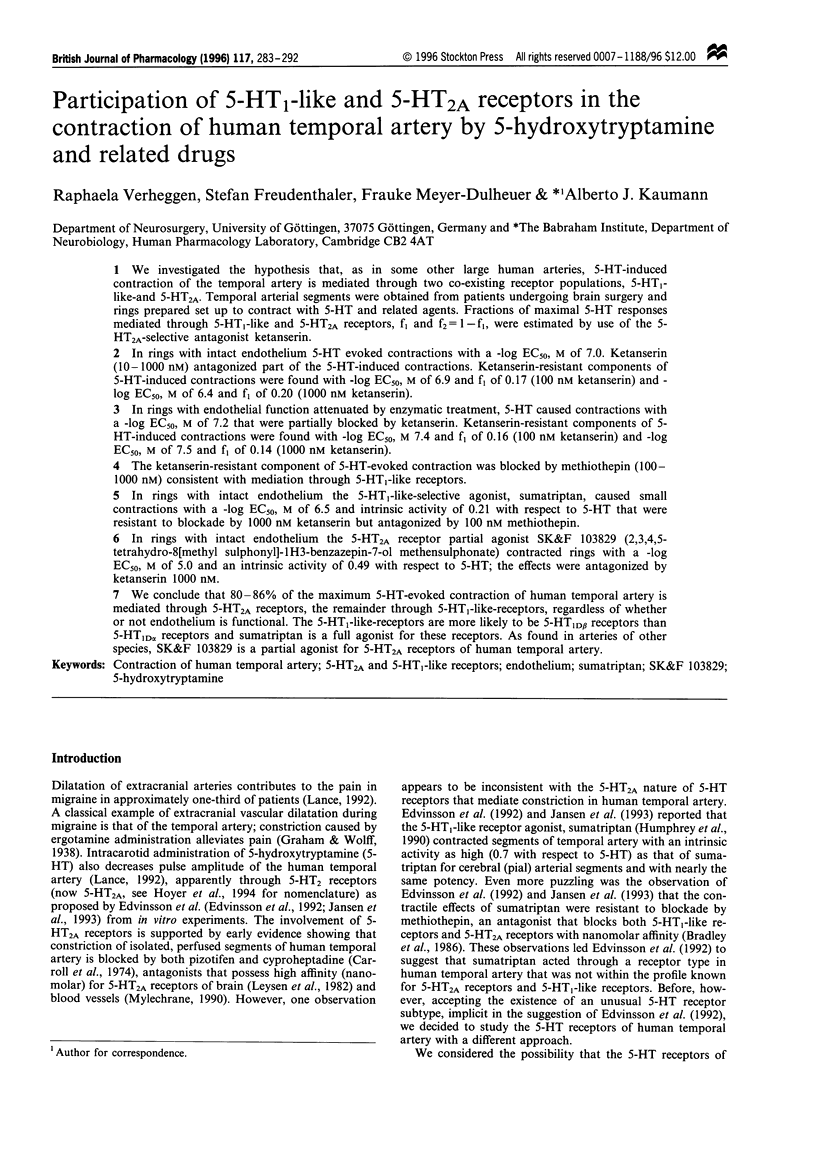
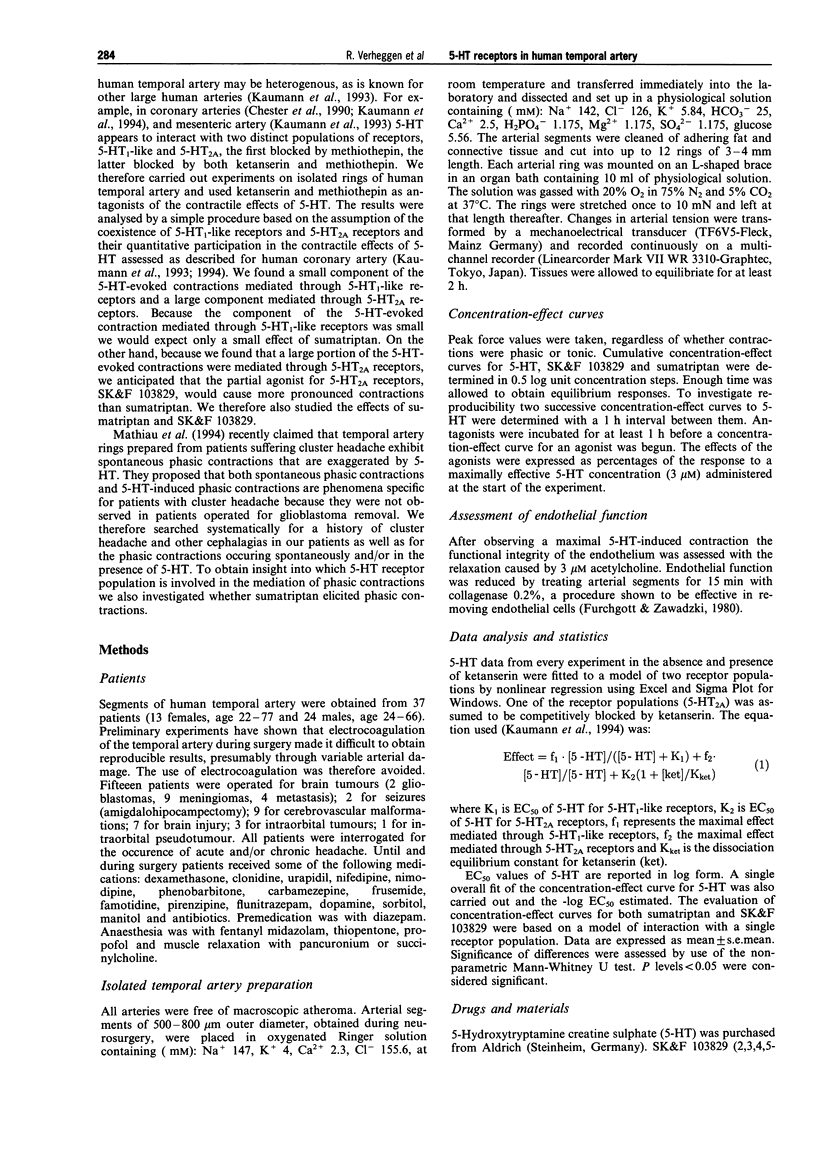
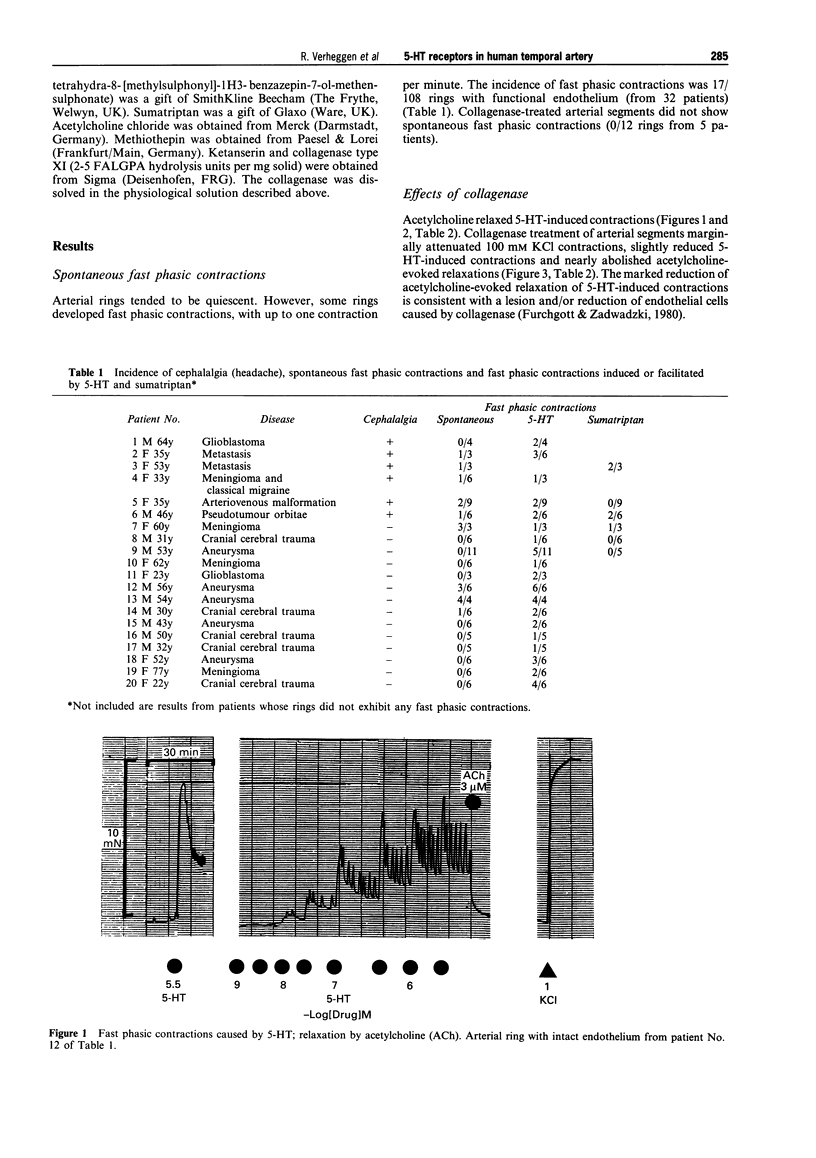
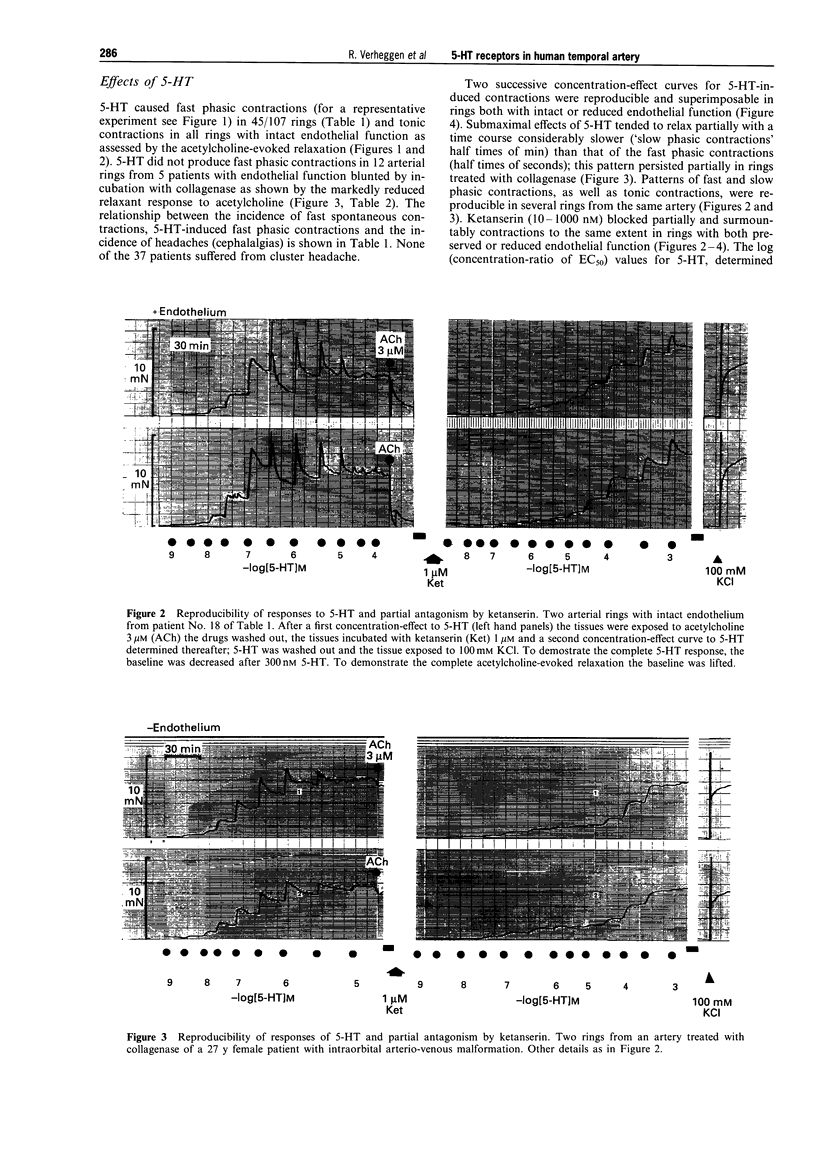
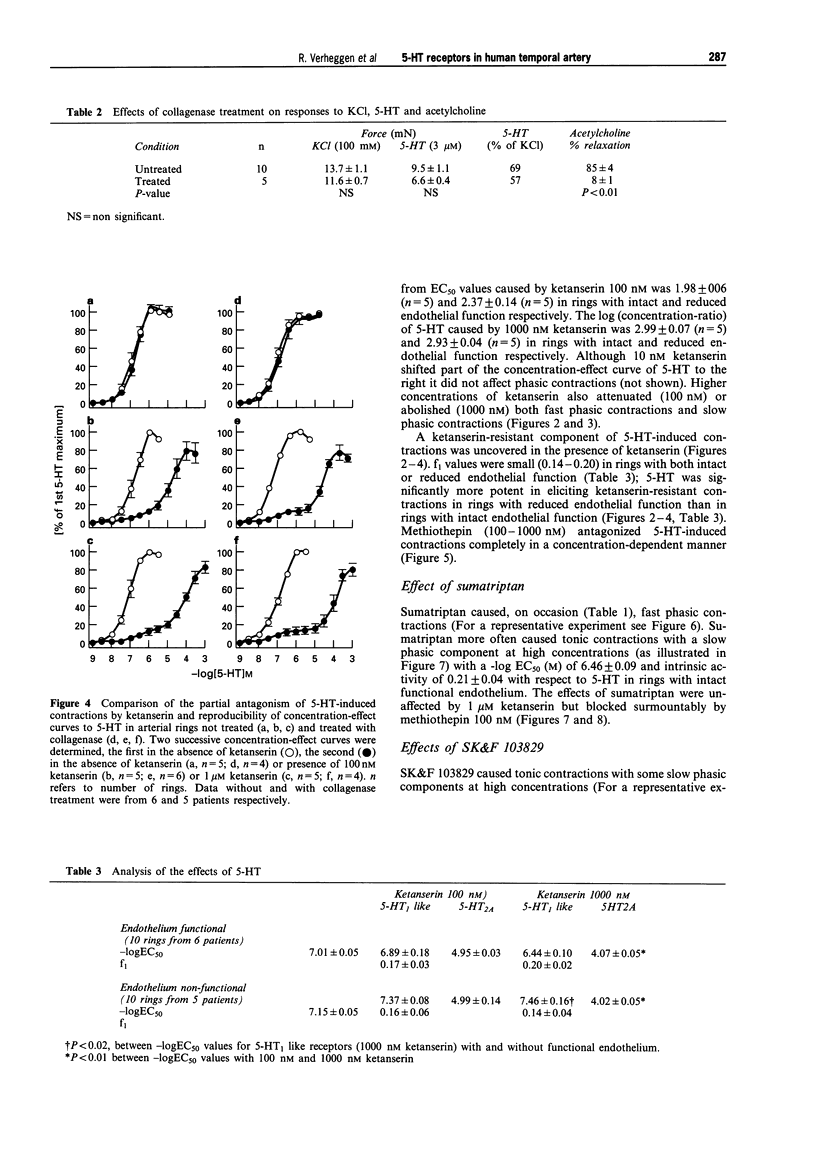
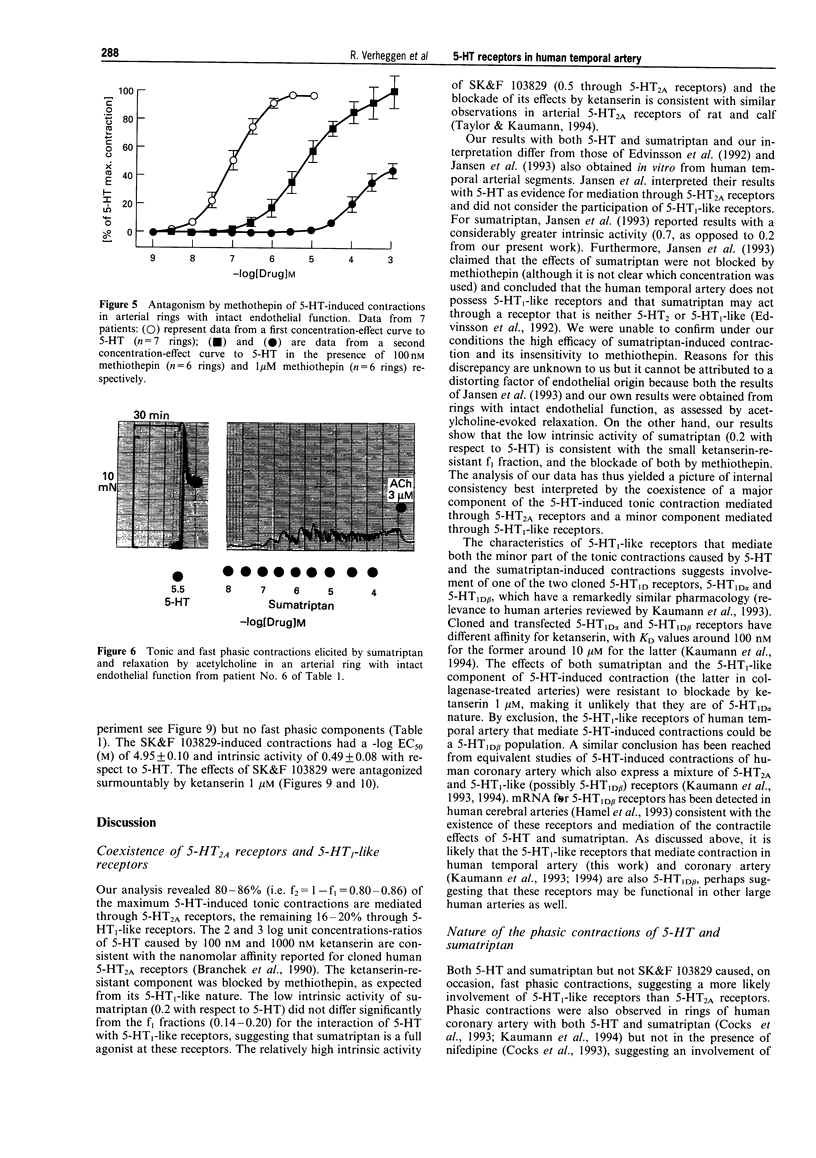
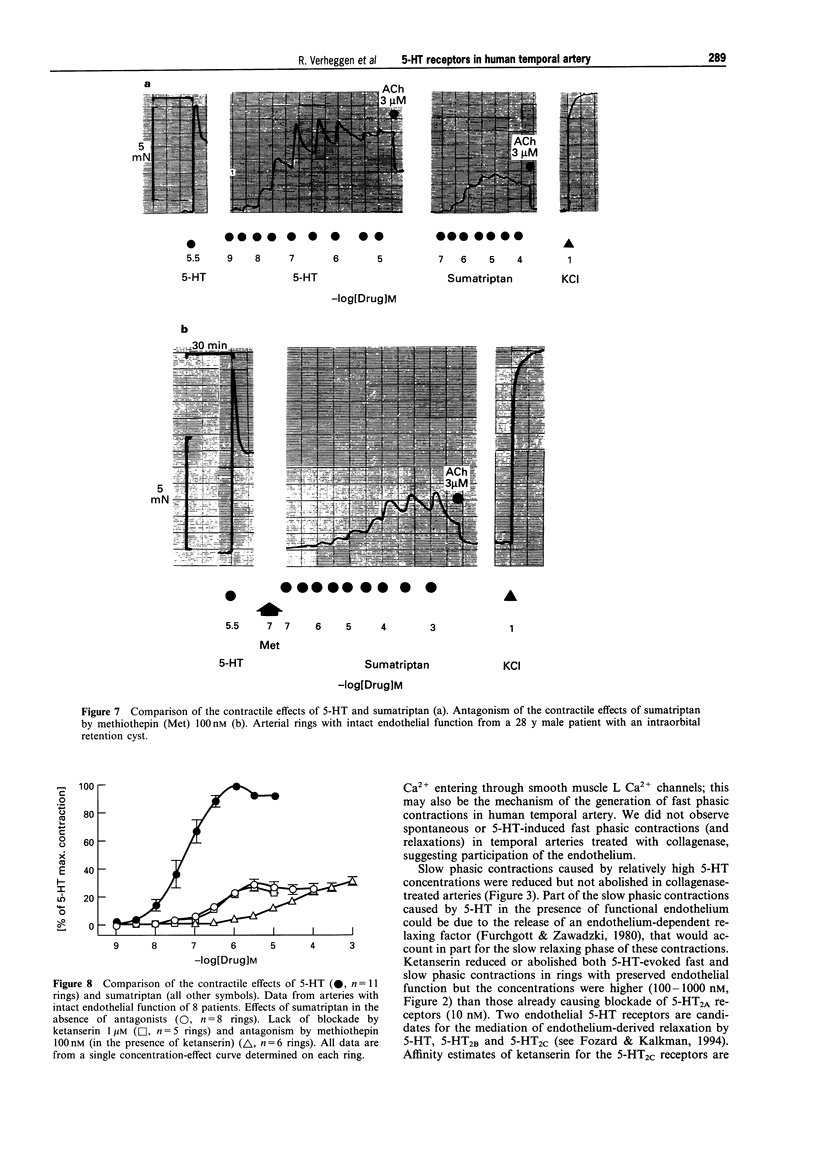
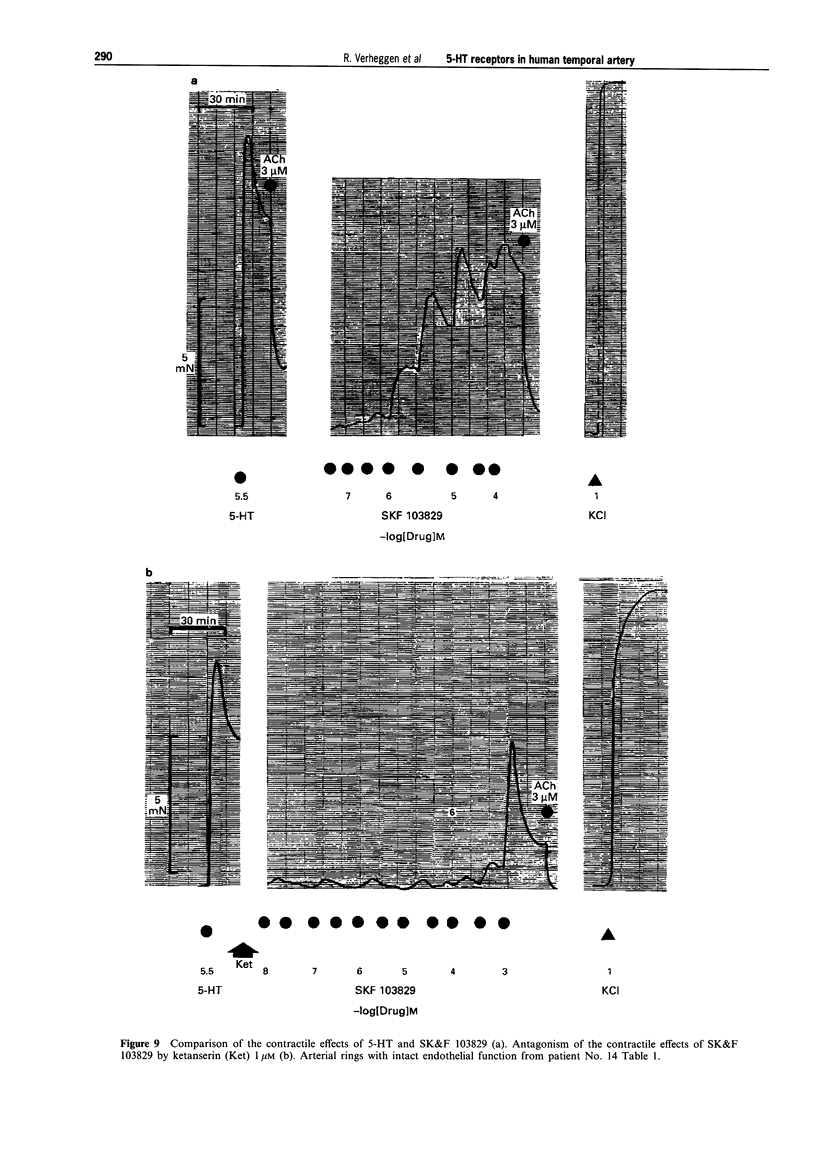
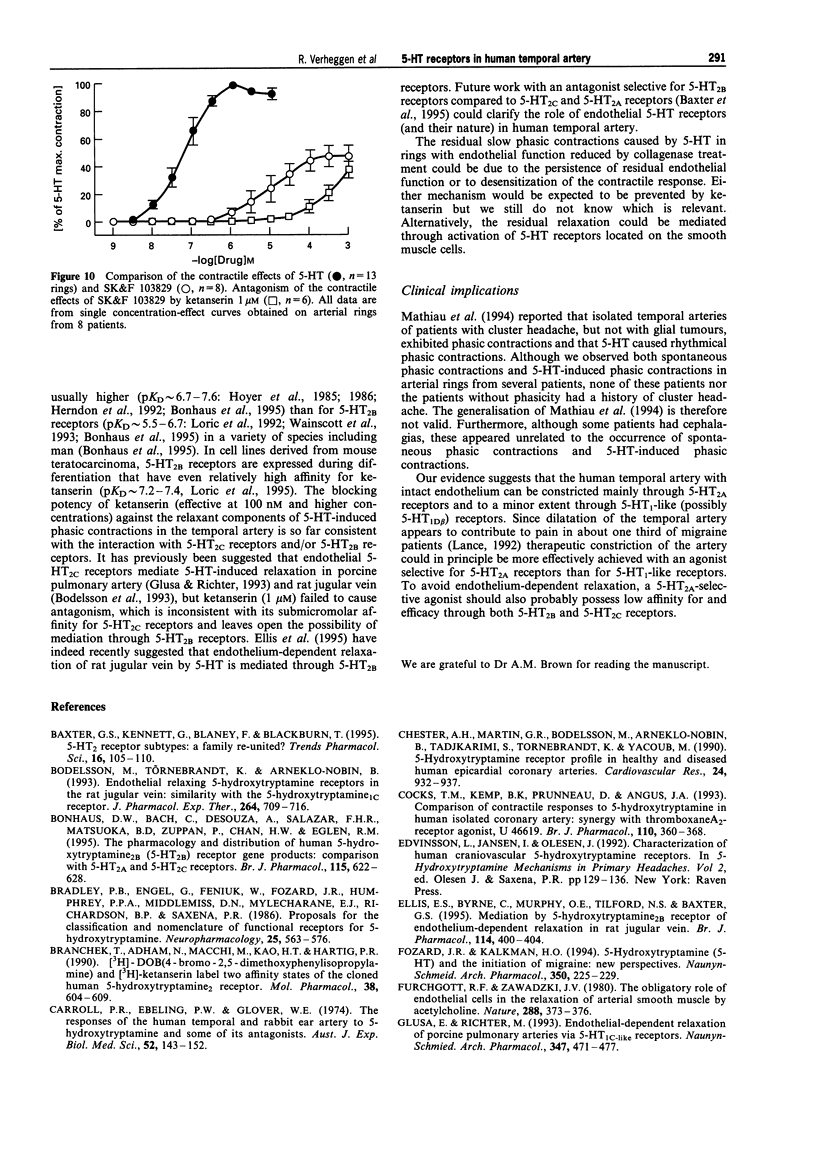
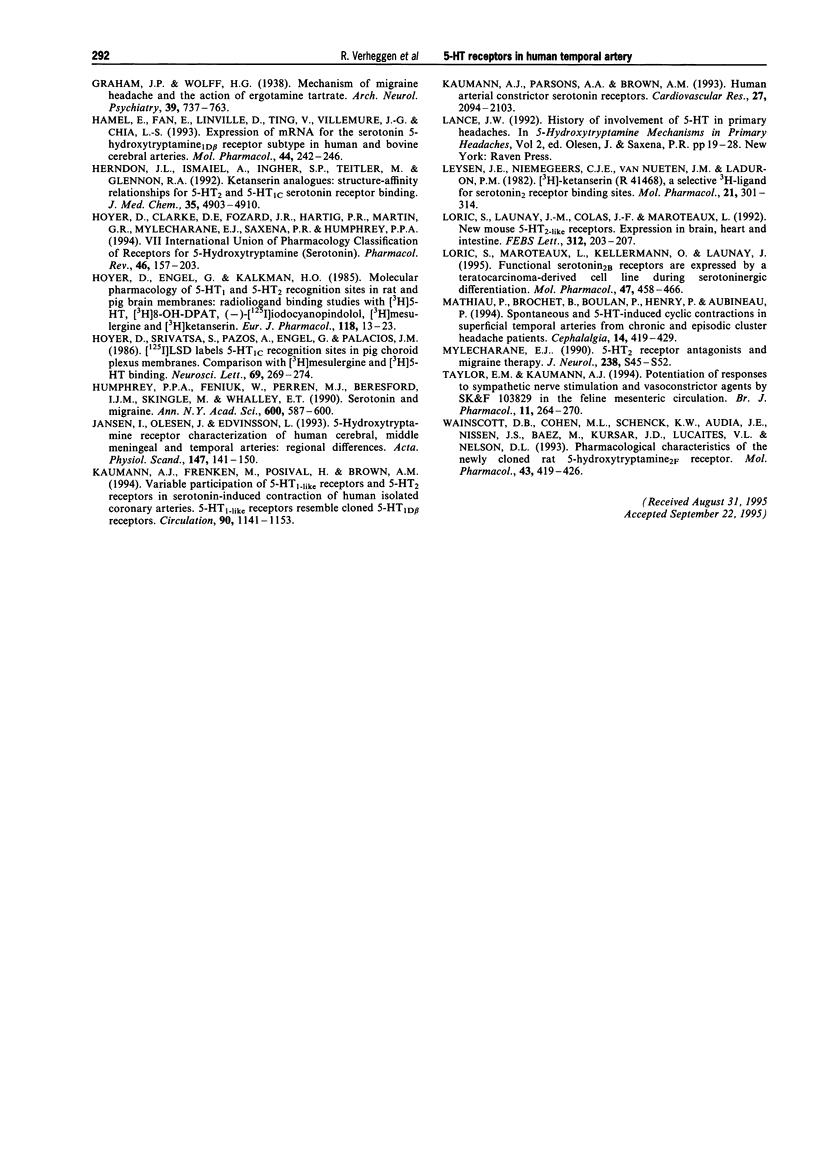
Selected References
These references are in PubMed. This may not be the complete list of references from this article.
- Baxter G., Kennett G., Blaney F., Blackburn T. 5-HT2 receptor subtypes: a family re-united? Trends Pharmacol Sci. 1995 Mar;16(3):105–110. doi: 10.1016/s0165-6147(00)88991-9. [DOI] [PubMed] [Google Scholar]
- Bodelsson M., Törnebrandt K., Arneklo-Nobin B. Endothelial relaxing 5-hydroxytryptamine receptors in the rat jugular vein: similarity with the 5-hydroxytryptamine1C receptor. J Pharmacol Exp Ther. 1993 Feb;264(2):709–716. [PubMed] [Google Scholar]
- Bonhaus D. W., Bach C., DeSouza A., Salazar F. H., Matsuoka B. D., Zuppan P., Chan H. W., Eglen R. M. The pharmacology and distribution of human 5-hydroxytryptamine2B (5-HT2B) receptor gene products: comparison with 5-HT2A and 5-HT2C receptors. Br J Pharmacol. 1995 Jun;115(4):622–628. doi: 10.1111/j.1476-5381.1995.tb14977.x. [DOI] [PMC free article] [PubMed] [Google Scholar]
- Bradley P. B., Engel G., Feniuk W., Fozard J. R., Humphrey P. P., Middlemiss D. N., Mylecharane E. J., Richardson B. P., Saxena P. R. Proposals for the classification and nomenclature of functional receptors for 5-hydroxytryptamine. Neuropharmacology. 1986 Jun;25(6):563–576. doi: 10.1016/0028-3908(86)90207-8. [DOI] [PubMed] [Google Scholar]
- Branchek T., Adham N., Macchi M., Kao H. T., Hartig P. R. [3H]-DOB(4-bromo-2,5-dimethoxyphenylisopropylamine) and [3H] ketanserin label two affinity states of the cloned human 5-hydroxytryptamine2 receptor. Mol Pharmacol. 1990 Nov;38(5):604–609. [PubMed] [Google Scholar]
- Chester A. H., Martin G. R., Bodelsson M., Arneklo-Nobin B., Tadjkarimi S., Tornebrandt K., Yacoub M. H. 5-Hydroxytryptamine receptor profile in healthy and diseased human epicardial coronary arteries. Cardiovasc Res. 1990 Nov;24(11):932–937. doi: 10.1093/cvr/24.11.932. [DOI] [PubMed] [Google Scholar]
- Cocks T. M., Kemp B. K., Pruneau D., Angus J. A. Comparison of contractile responses to 5-hydroxytryptamine and sumatriptan in human isolated coronary artery: synergy with the thromboxane A2-receptor agonist, U46619. Br J Pharmacol. 1993 Sep;110(1):360–368. doi: 10.1111/j.1476-5381.1993.tb13818.x. [DOI] [PMC free article] [PubMed] [Google Scholar]
- Ellis E. S., Byrne C., Murphy O. E., Tilford N. S., Baxter G. S. Mediation by 5-hydroxytryptamine2B receptors of endothelium-dependent relaxation in rat jugular vein. Br J Pharmacol. 1995 Jan;114(2):400–404. doi: 10.1111/j.1476-5381.1995.tb13240.x. [DOI] [PMC free article] [PubMed] [Google Scholar]
- Fozard J. R., Kalkman H. O. 5-Hydroxytryptamine (5-HT) and the initiation of migraine: new perspectives. Naunyn Schmiedebergs Arch Pharmacol. 1994 Sep;350(3):225–229. doi: 10.1007/BF00175026. [DOI] [PubMed] [Google Scholar]
- Furchgott R. F., Zawadzki J. V. The obligatory role of endothelial cells in the relaxation of arterial smooth muscle by acetylcholine. Nature. 1980 Nov 27;288(5789):373–376. doi: 10.1038/288373a0. [DOI] [PubMed] [Google Scholar]
- Glusa E., Richter M. Endothelium-dependent relaxation of porcine pulmonary arteries via 5-HT1C-like receptors. Naunyn Schmiedebergs Arch Pharmacol. 1993 May;347(5):471–477. doi: 10.1007/BF00166737. [DOI] [PubMed] [Google Scholar]
- Hamel E., Fan E., Linville D., Ting V., Villemure J. G., Chia L. S. Expression of mRNA for the serotonin 5-hydroxytryptamine1D beta receptor subtype in human and bovine cerebral arteries. Mol Pharmacol. 1993 Aug;44(2):242–246. [PubMed] [Google Scholar]
- Herndon J. L., Ismaiel A., Ingher S. P., Teitler M., Glennon R. A. Ketanserin analogues: structure-affinity relationships for 5-HT2 and 5-HT1C serotonin receptor binding. J Med Chem. 1992 Dec 25;35(26):4903–4910. doi: 10.1021/jm00104a017. [DOI] [PubMed] [Google Scholar]
- Hoyer D., Clarke D. E., Fozard J. R., Hartig P. R., Martin G. R., Mylecharane E. J., Saxena P. R., Humphrey P. P. International Union of Pharmacology classification of receptors for 5-hydroxytryptamine (Serotonin). Pharmacol Rev. 1994 Jun;46(2):157–203. [PubMed] [Google Scholar]
- Hoyer D., Engel G., Kalkman H. O. Molecular pharmacology of 5-HT1 and 5-HT2 recognition sites in rat and pig brain membranes: radioligand binding studies with [3H]5-HT, [3H]8-OH-DPAT, (-)[125I]iodocyanopindolol, [3H]mesulergine and [3H]ketanserin. Eur J Pharmacol. 1985 Nov 26;118(1-2):13–23. doi: 10.1016/0014-2999(85)90658-2. [DOI] [PubMed] [Google Scholar]
- Hoyer D., Srivatsa S., Pazos A., Engel G., Palacios J. M. [125I]LSD labels 5-HT1C recognition sites in pig choroid plexus membranes. Comparison with [3H]mesulergine and [3H]5-HT binding. Neurosci Lett. 1986 Sep 12;69(3):269–274. doi: 10.1016/0304-3940(86)90492-1. [DOI] [PubMed] [Google Scholar]
- Humphrey P. P., Feniuk W., Perren M. J., Beresford I. J., Skingle M., Whalley E. T. Serotonin and migraine. Ann N Y Acad Sci. 1990;600:587–600. doi: 10.1111/j.1749-6632.1990.tb16912.x. [DOI] [PubMed] [Google Scholar]
- Jansen I., Olesen J., Edvinsson L. 5-Hydroxytryptamine receptor characterization of human cerebral, middle meningeal and temporal arteries: regional differences. Acta Physiol Scand. 1993 Feb;147(2):141–150. doi: 10.1111/j.1748-1716.1993.tb09483.x. [DOI] [PubMed] [Google Scholar]
- Kaumann A. J., Frenken M., Posival H., Brown A. M. Variable participation of 5-HT1-like receptors and 5-HT2 receptors in serotonin-induced contraction of human isolated coronary arteries. 5-HT1-like receptors resemble cloned 5-HT1D beta receptors. Circulation. 1994 Sep;90(3):1141–1153. doi: 10.1161/01.cir.90.3.1141. [DOI] [PubMed] [Google Scholar]
- Kaumann A. J., Parsons A. A., Brown A. M. Human arterial constrictor serotonin receptors. Cardiovasc Res. 1993 Dec;27(12):2094–2103. doi: 10.1093/cvr/27.12.2094. [DOI] [PubMed] [Google Scholar]
- Leysen J. E., Niemegeers C. J., Van Nueten J. M., Laduron P. M. [3H]Ketanserin (R 41 468), a selective 3H-ligand for serotonin2 receptor binding sites. Binding properties, brain distribution, and functional role. Mol Pharmacol. 1982 Mar;21(2):301–314. [PubMed] [Google Scholar]
- Loric S., Launay J. M., Colas J. F., Maroteaux L. New mouse 5-HT2-like receptor. Expression in brain, heart and intestine. FEBS Lett. 1992 Nov 9;312(2-3):203–207. doi: 10.1016/0014-5793(92)80936-b. [DOI] [PubMed] [Google Scholar]
- Loric S., Maroteaux L., Kellermann O., Launay J. M. Functional serotonin-2B receptors are expressed by a teratocarcinoma-derived cell line during serotoninergic differentiation. Mol Pharmacol. 1995 Mar;47(3):458–466. [PubMed] [Google Scholar]
- Mathiau P., Brochet B., Boulan P., Henry P., Aubineau P. Spontaneous and 5HT-induced cyclic contractions in superficial temporal arteries from chronic and episodic cluster headache patients. Cephalalgia. 1994 Dec;14(6):419–393. doi: 10.1046/j.1468-2982.1994.1406419.x. [DOI] [PubMed] [Google Scholar]
- Mylecharane E. J. 5-HT2 receptor antagonists and migraine therapy. J Neurol. 1991;238 (Suppl 1):S45–S52. doi: 10.1007/BF01642906. [DOI] [PubMed] [Google Scholar]
- Taylor E. M., Kaumann A. J. Potentiation of responses to sympathetic nerve stimulation and vasoconstrictor agents by SK&F 103829 in the feline mesenteric circulation. Br J Pharmacol. 1994 Jan;111(1):264–270. doi: 10.1111/j.1476-5381.1994.tb14054.x. [DOI] [PMC free article] [PubMed] [Google Scholar]
- Wainscott D. B., Cohen M. L., Schenck K. W., Audia J. E., Nissen J. S., Baez M., Kursar J. D., Lucaites V. L., Nelson D. L. Pharmacological characteristics of the newly cloned rat 5-hydroxytryptamine2F receptor. Mol Pharmacol. 1993 Mar;43(3):419–426. [PubMed] [Google Scholar]


